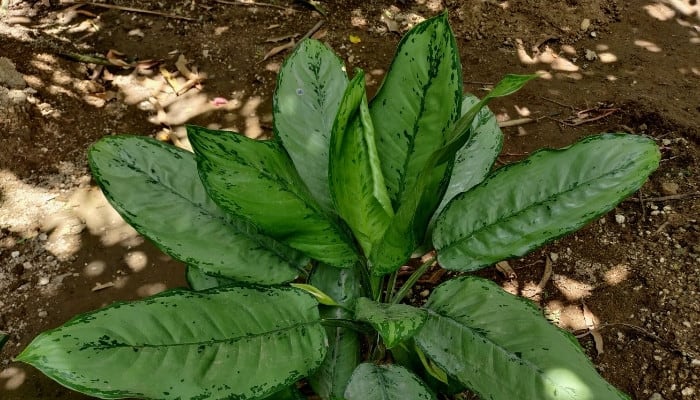The Aglaonema pictum is an attractive plant that originates from Sumatra, Indonesia.
Most indoor plant collectors seek out this plant for its dramatic foliage, sporting camouflage patterns in rich green, dark green, and cream.
Aglaonema pictum is an evergreen perennial known to grow on the slopes of major volcanoes and along shady forest floors.
How do you care for Aglaonema pictum? To keep Aglaonema pictum thriving and to preserve the camouflage leaf pattern, provide bright, indirect sunlight and a well-draining soil mix of perlite, orchid bark, and peat. Maintain 65-90% humidity and water often so the soil never dries out. Fertilize twice monthly in spring and summer.
Caring for Aglaonema Pictum: Basic Guidelines
Complete Care Guide for Aglaonema Pictum
The Aglaonema pictum is an easy-growing low-maintenance plant. It enjoys low lighting conditions, and most indoor spaces can imitate its ideal environment easily.
Aglaonema Pictum at a Glance
- Scientific Name: Aglaonema Pictum
- Plant Type: Subtropical
- Average Height: 10-20 inches
- Average Width: ½ inch
- Growth Rate: Slow
- Produces Flowers: Yes
- Common Pests: Spider mites, mealybugs, aphids, scales
- Level of Care: Low maintenance
What To Do When You First Get Your Aglaonema Pictum
Choose a warm position for your plant, preferably near an east or north-facing window. The light should be moderate and gentle.
Place the Aglaonema pictum on a pebble tray with water to encourage humidity.
Ideal Soil for Aglaonema Pictum
These plants enjoy a rich, fertile soil that drains quickly. A good potting mix for this plant is three parts coco peat, one part compost, and three parts pumice or perlite.
Aglaonema Pictum Water Requirements
The Aglaonema pictum enjoys regular watering but doesn’t like water-logged soil. Check if the top 2 inches of soil are dry before watering.
Aglaonema Pictum Lighting Needs
These plants enjoy low light with intermittent sunny spells, much like their natural habitat.
They can tolerate much lower light conditions than most indoor plants but need adequate light to maintain their unique leaf designs.
Choose a moderate light source, such as near a well-lit window.
Ideal Temperature Range for Aglaonema Pictum
This subtropical plant is used to mellow temperatures that do not dip anywhere near freezing; it’s not frost resistant.
It prefers temperatures above 50℉ (10℃) and between 60-65℉ (16 – 18℃) in winter.
Ideal Humidity Level for Aglaonema Pictum
Subtropical plants love humidity, and the Aglaonema pictum is no exception. It enjoys humidity levels of 65% and more.
Best Location for Aglaonema Pictum
Place near an east- or north-facing window.
Although this plant can tolerate short periods of direct sunlight, its leaves can easily scorch, so it is best positioned in low, indirect light.
Aglaonema Pictum Growth Habits
The growth rate of the Aglaonema pictum is slow and steady. It can reach a height of 12-20 inches (30-50 cm) with a stem width of 0.8 inches (2 cm).
Fertilization Type & Schedule for Aglaonema Pictum
The Aglaonema pictum requires feeding in the spring and summer. Use a nitrogen-rich fertilizer to promote dense and striking greenery.
Some fertilizers are too intense for this plant and burn the roots, so it’s best to dilute the dosage to half the strength.
Signs of Nutrient Deficiency
The first sign of nutrient deficiency is drooping leaves. This is usually an indication of inadequate amounts of light and water.
Check the lighting conditions are not so low that the plant is unable to photosynthesize, and ensure the soil is moist.
Pruning Aglaonema Pictum
For plant lovers who enjoy the art of pruning, this is not the plant on which to practice.
While the Aglaonema pictum is quite happy for you to remove dead leaves and flowers by hand, any overzealous pruning can damage its health indefinitely.
Also, removing leaves from the crown, where the leaves materialize, can cause tissue damage causing the plant to die.
Does Aglaonema Pictum Produce Flowers?
Aglaonema pictum produces flowers in the spring and summer seasons. The plant grows a spadix, which is a spike of tiny white and greenish flowers.
The female flowers are found at the bottom and male flowers at the tip of the spadix. The flowers form scarlet or amber berries.
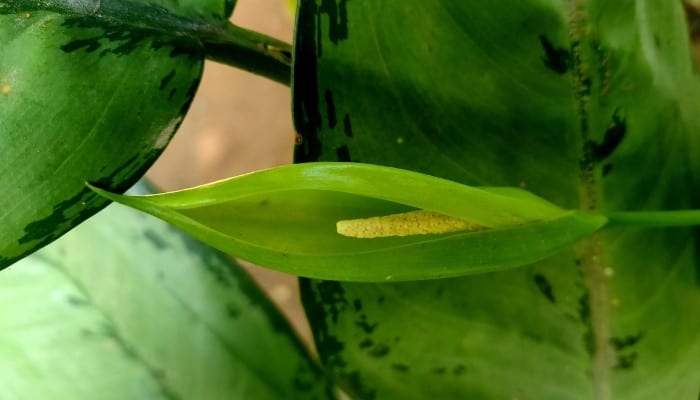
Is Aglaonema Pictum Toxic?
The Aglaonema pictum is best kept away from pets and children. The plant contains crystals called calcium oxalate.
On ingestion, animals may struggle to swallow and experience swelling of the mouth and tongue, and vomiting or foaming at the mouth.
For humans, stomach aches, irritation of mucus membranes, and painful rashes occur.
Aglaonema Pictum Propagation
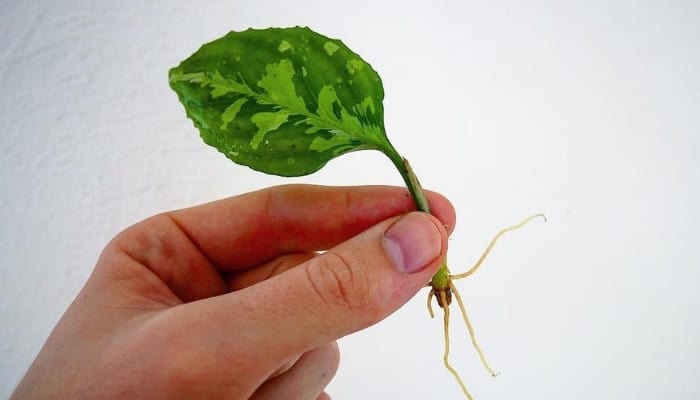
Image credit: Plant that plant
The best time to propagate your Aglaonema pictum is in spring and summer. There are two ways to propagate: stem cuttings and seed propagation.
Stem Propagation of Aglaonema Pictum
Using stem cuttings is the most common form of propagation for the Aglaonema pictum. You will need to use clean sterilized scissors and gardening gloves
1. Cut a Stem From the Parent Plant With Leaves Attached
Using scissors, snip off a leaf stem from the parent plant. The stem cutting should be about 6 inches (15 cm) with five leaves attached.
The stem should also have at least one leaf node.
2. Place the Cutting Into a Pot of Moist Soil
Dry the cutting and dip the end in some rooting powder. I’ve had fast, excellent results with this rooting hormone.
Place the Aglaonema cutting in a pot of moist soil, about 2 inches deep, and position in a place that is warm and bright. It can take 25 to 45 days to see new shoots.
*Alternatively, you can place the cuttings in water and grow them hydroponically until there is enough new root growth present to confidently transfer them to soil.
Propagating Aglaonema Pictum With Seeds
1. Remove the Scarlet or Amber Berries From the Base of the Spadix
Collect the berries, and open the fleshy covering to remove the seeds. Wash the seeds thoroughly.
2. Fill a Shallow Pot With Coco Peat Mix and Spread the Seeds Evenly
Use a shallow pot filled with coco peat mix or a mix of equal parts peat and sand. Spread the seeds on the surface of the peat, and cover gently with a light layer of soil.
Place in a warm room, ensuring the seeds receive sufficient indirect light. Seeds take 45 to 60 days to germinate.
3. Caring for Your Seedlings
Seedlings are just as slow-growing as the parent plant and will take time to develop and mature. Keep the seedling Aglaonema pictum at a warm temperature.
Repotting Aglaonema Pictum
The Aglaonema pictum enjoys a smaller pot and being semi rootbound. This slow-growing plant only needs to be repotted every three to five years.
Should you need to repot your Aglaonema, it’s best to use only a slightly larger container.
Signs That It’s Time To Repot
- Yellowing leaves
- Soil not retaining water
- Roots tightly wrapped inside the pot
- Plant container bulging
- Roots peeping through drainage holes
How To Repot Aglaonema Pictum
1. Select a Container 2 Inches Larger Than the Old One
If you use an oversize container this means excess soil around the roots, which increases the chances of root rot and disease.
2. Carefully Tip the Plant Out of Its Container Into Your Hand
Using your fingers, loosen the roots and remove excess old potting mix. Try to avoid breaking roots – this is a gentle process, not a tug of war.
3. Half Fill the Container With Coco Peat or Equal Parts of Peat and Sand
Make a deep well in the fresh soil, and place the root ball into the hole.
Add more potting soil until the container is full. Gently press the soil down around the base of the plant.
4. Water Well and Ensure the Soil Is Moist
Water the plant well and keep the soil moist for a week before resuming your ordinary watering schedule.
5. Provide the Plant With Added Care
Some plants suffer from a bit of shock after being moved out of their usual living arrangements, and the Aglaonema pictum is no exception.
Continue to care for them, supplying adequate lighting, heat, and warmth, and your plant is sure to recuperate.
Aglaonema Pictum Common Problems & Solutions That Work
Aglaonema Pictum Common Pests
Like most indoor plants, Aglaonema pictum is susceptible to common pests, such as spider mites and scale.
Spider Mites
Signs of Trouble
Speckled or mottled discoloration on the leaves that are white or yellow in color. Spider mites suck the chlorophyll out of plants causing the leaf to discolor.
Solution
Mix 2 tablespoons of neem oil (this one is excellent) to 1 gallon of water. Spray the solution over the plant, concentrating on the lower surface of the leaves.
To resolve infestations, spray continuously for seven days.
Prevention
In addition to regularly spraying with neem oil every two weeks, you can also put preventive measures in place.
For instance, spider mites hate moisture, so by increasing the humidity levels around your plant and keeping it hydrated, you can prevent spider mites from settling on your plant.
Scale
Signs of Trouble
Unsightly brown oval bulges appear on the leaves alongside wet patches that are not water but honeydew residue resulting from the scale feeding on the plant.
Solution
Remove the scale from the leaves using a flat blade. Rinse off any sticky honeydew residue and baby scale called crawlers. Spray generously with insecticidal soap.
Alternatively, you can mix 1/2 teaspoon of neem oil with natural soap (soap-nut liquid). Spray the solution mixed with water over the entire plant, and repeat once a week.
Prevention
Regularly check your plants for signs of scale and treat them immediately.
Aglaonema Pictum Common Diseases
This plant can suffer from bacterial-related leaf diseases.
Bacterial Leaf Spot
Signs of Trouble
Leaves develop inconsistently shaped, dark spots that grow in size, killing the foliage tissue.
Solution
Mix 1 tablespoon of baking soda and 2 1/2 tablespoons of horticulture oil or vegetable oil in a gallon of water, and add 1 teaspoon of liquid dish soap.
Mix thoroughly and pour into a reusable spray bottle. Mist the plant with the solution and repeat every two weeks.
Prevention
Reduce humidity levels, avoid spraying the leaves when watering, and avoid overcrowding plants. Dispose of infected leaves and stems immediately.
Copper Deficiency
Signs of Trouble
New leaves are yellow in color and appear distorted. Stunted growth and pale leaves soon follow.
Solution
Apply copper sulfate to soil surfaces or apply a copper spray to the leaves (this one also works as a fungicide).
Most commercial copper sprays are premixed, but if not, follow the mixing guide strictly.
Prevention
Use good quality soil when repotting your Aglaonema pictum. Ensure the plant is being fertilized during growth periods and is receiving the correct nutrients.
Other Common Problems
The Aglaonema pictum is relatively easygoing and doesn’t often have issues concerning its health. However, as with all plants, some pretty common problems do occur.
Brown Leaves
Signs of Trouble
Leaves become brown-colored and brittle.
Solution
This is a sign your soil is too dry and your plant is severely dehydrated. Water the plant thoroughly and maintain a good watering schedule in the future.
The damaged leaves won’t turn green again, but future growth should return to its original coloring.
Prevention
Ensure the soil drains easily and water the plant when the top 2 inches of soil are dry.
You could also try self-watering pot plant containers if you find it difficult to maintain a watering schedule.
Curling or Drooping Leaves
Signs of Trouble
Leaves start to droop or curl.
Solution
This can be a sign of your Aglaonema being dehydrated or a result of over-exposure to sunlight.
If the Aglaonema pictum is exposed to lots of direct sunlight throughout the day, its leaves will droop and curl.
Move the plant to a shaded position. Next, ensure your plant receives enough water to keep the soil moist but not soggy.
Lastly, check that your plant is receiving enough humidity. Place your plant on a pebble tray filled with water to increase humidity.
Prevention
Increase your watering routine, although you need to ensure that watering is done when the top 2 inches of soil are dry.
Yellowing Leaves
Signs of Trouble
Leaves turn yellow in color and appear sickly.
Solution
While it’s perfectly normal for leaves to yellow and die from age, if your Aglaonema pictum suddenly has many leaves turn yellow, your plant is trying to get your attention.
Yellowing leaves are a sign of overwatering, which can cause root rot and the death. Check to see if your plant’s root system is healthy.
If roots are brown and squishy, it’s a sign root rot has set in, which is not reversible.
If the roots appear healthy, reduce your watering schedule to keep the soil moist. Also, check the soil is draining correctly.
Prevention
Decrease your watering routine, and stick to the gardener’s golden rule of only watering when the top 2 inches of soil are dry to the touch.
Aglaonema Pictum Common Questions
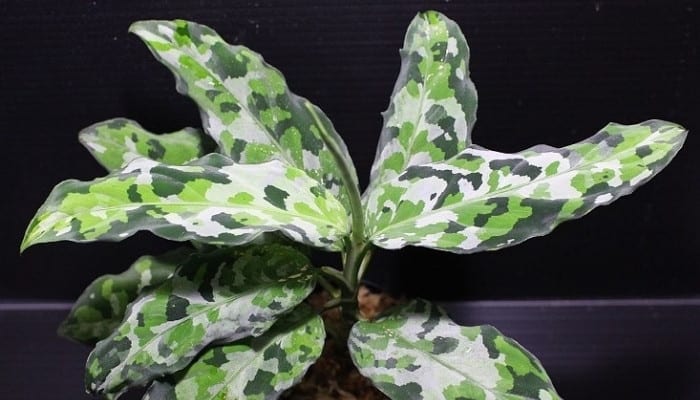
Image credit: Jamie’s Jungle
Aglaonema Pictum Bicolor vs. Aglaonema Pictum Tricolor
Aglaonema pictum ‘Bicolor’ has two predominant colors on its leaves – lime and dark green creating a marbled effect.
The Aglaonema pictum ‘Tricolor’ has three shades – light green, dark green, and white. Both require the same care.
Is Aglaonema Pictum the Same as a Camouflage Plant?
The Aglaonema pictum is often called the camouflage plant due to the mottled green and white colors on its leaves that closely resemble army uniform colors.
Is Aglaonema Pictum the Same as a Chinese Evergreen Plant?
Many plants in the Aglaonema genus, including Aglaonema pictum are commonly called Chinese evergreen plants due to the fact that they originated in Asia and maintain lovely foliage all year when cared for properly.
Can You Grow Aglaonema Pictum Tricolor Seeds?
You can propagate Aglaonema pictum ‘Tricolor’ from fresh seeds found at the base of the spadix.
Place the seeds in a coco peat mix in a warm room. The seeds can take 45 – 60 days to germinate.
Can You Put Aglaonema Pictum Outside?
Outside of its native warm and balmy habitat, the Aglaonema pictum is predominantly grown indoors due to its dislike of colder temperatures.
You could place the plant outdoors in the summer months, but you have to watch the temperature doesn’t dip below 50℉ to prevent cold damage.
Is Aglaonema Pictum a Lucky Plant?
The Aglaonema pictum is seen as a symbol of good fortune in Chinese culture and is often referred to as being a lucky plant. It is also commonly called the Chinese evergreen plant.
Is Aglaonema Pictum an Air Purifier?
The Aglaonema pictum can remove harmful air pollutants found in the air, such as formaldehyde and benzene.
It also produces oxygen that improves the air quality of your home or office.
How Can I Make My Aglaonema Pictum Bushy?
Pinch off new leaves on young plants using your fingers. For mature plants, use sharp, clean pruning shears to remove new growth.
It’s also worth noting that this plant has naturally dense foliage, so the need for pruning is rare. However, removing dead leaves and foliage will encourage bushier growth.
How Do You Make Aglaonema Pictum Grow Faster?
Pruning can encourage faster growth, as will removing dead leaves. Fertilize during the growing period to ensure the plant is receiving enough nutrients.
How Much Does an Aglaonema Pictum Cost?
The price of Aglaonema pictum depends mainly on where the plant is purchased.
However, the Aglaonema pictum is generally considered a pricey indoor plant and can cost between $150 and $300.
Why Is Aglaonema Pictum So Expensive?
This plant can be rather difficult to source and purchase, resulting in its costly price tag.
However, many online plant suppliers have realized the popularity of this plant, so the plants are becoming more readily available.
How Many Types of Aglaonema Are There?
The Aglaonema genus consists of many different species, 40 at last count.
Additionally, each species often has several (or many) cultivars, each with unique markings, foliage, and colors.
5 Key Tips for Success With Aglaonema Pictum

Image credit: ILLExotics
- Position in a warm spot, exposed to indirect light. Direct sunlight can scorch the sensitive leaves of the Aglaonema.
- Air conditioning and heating can dry out your subtropical plant; it’s best to keep the plant in humid conditions, which you can create using a pebble tray filled with water or by purchasing a humidifier.
- Fertilize using diluted fertilizer during the growing season. Avoid over-fertilizing as it can burn the roots if fed too often.
- Ensure your plant container has sufficient drainage holes for excess water to flow through. Waterlogged soil can quickly lead to root rot in Aglaonema.
- Water your plant when the top two inches of soil are dry to the touch. This will prevent overwatering and subsequent root rot and drooping leaves.
Conclusion
This warmth-loving subtropical plant is a gorgeous and colorful addition to any home.
By following the clear care instructions in this guide, you are sure to have a happy, healthy Aglaonema pictum in your home.
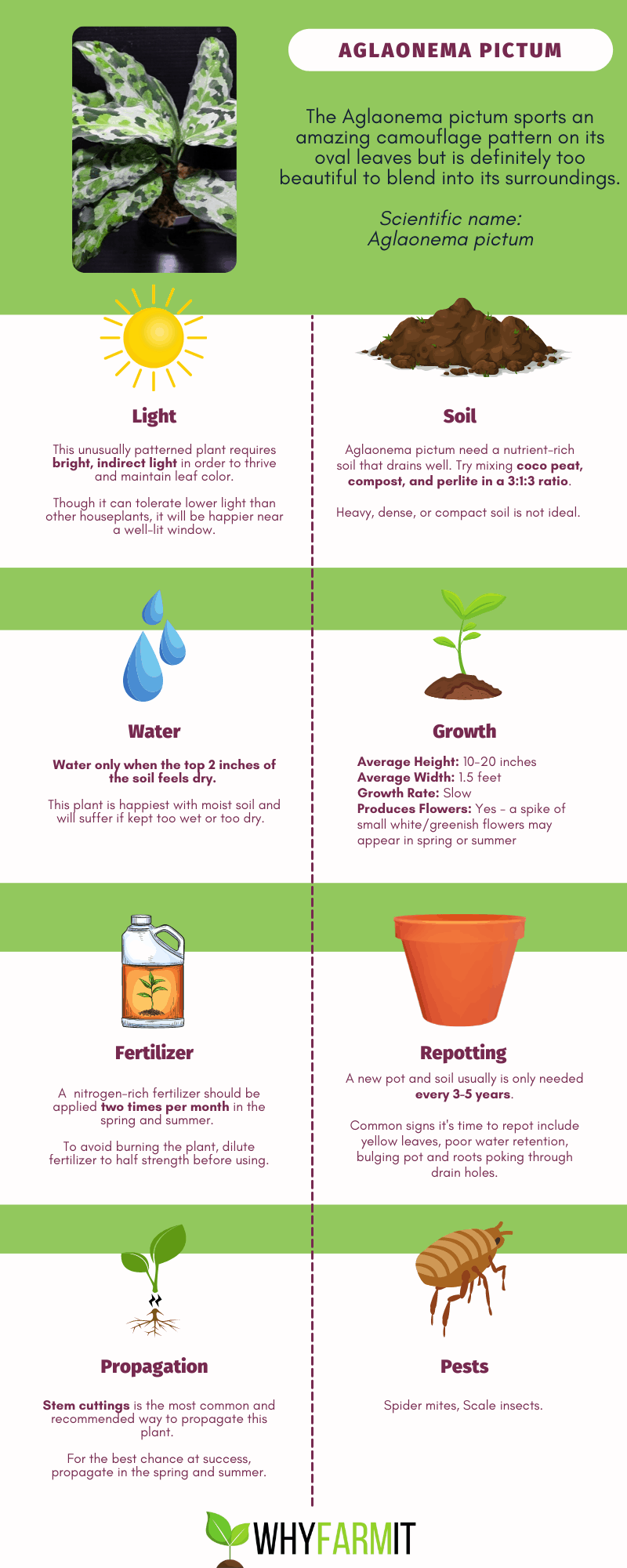
Image credits: Plant that plant, Jamie’s Jungle, ILLExotics

